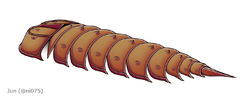Biology:Willwerathia
| Willwerathia | |
|---|---|

| |
| Reconstruction of Willwerathia laticeps | |
| Scientific classification | |
| Kingdom: | |
| Phylum: | |
| Subphylum: | |
| Order: | |
| Genus: | †Willwerathia
Størmer, 1969 |
| Species | |
| |
Willwerathia is a genus of Devonian arthropod. It is sometimes classified as synziphosurine,[1][2] a paraphyletic group of horseshoe crab-like fossil chelicerate arthropods,[2] while some studies compare its morphology to an artiopod.[3][4] Willwerathia known only by one species, Willwerathia laticeps, discovered in deposits of the Devonian period from the Klerf Formation, in the Rhenish Slate Mountains of Germany .[1][5]
Morphology
As a synziphosurine, Willwerathia is unusually large and so far the largest known synziphosurine, with largest carapace measured about 90mm in width.[1] Prosoma of Willwerathia covered by a vaulted carapace with pointed genal spines, recurved (M-shaped) ophthalmic ridges and pairs of dorsal nodes.[1] Tergites of the opisthosoma are either incomplete or disarticulated in available fossil materials, making it difficult to reveal the original number of opisthosomal segments.[1] The opisthosoma of Willwerathia most likely compose of 10 segments, each expressed by a tergite that bore a median dorsal spine and a pair of tergopleurae (lateral extensions).[1] The opisthosoma subdivided into a wider, most likely 7-segmented preabdomen and a narrower, 3-segmented postabdomen.[1] tergite of the first opisthosomal segment is reduced in length while the remaining segments possess well-developed tergites with lateral nodes and posteriorly curved tergopleurae. The final segment terminated with a short, teardrop-shaped telson.[1]
Paleoecology
Willwerathia was most likely a bottom-dwelling predator.[1] The marked articulation surfaces on each of the preabdominal segments suggest that Willwerathia capable to enroll itself in a way similar to Legrandella.[1] The environment in which Wilwerathia lived in was likely an estuarine to deltaic one, and other animals like the largest eurypterid, Jaekelopterus, are known from the same formation.[6]
Classification
Willwerathia was originally thought to be an eurypterid (sea scorpion), with additional fossils described in 1998 reveal its synziphosurine affinities.[1] In the redescription done by Anderson et al. 1998, Willwerathia had been grouped under the synziphosurine family Weinberginidae alongside Weinbergina and Legrandella,[1] a classification which is not supported by phylogenetic analysis.[2] Willwerathia was regarded as part of the monophyletic Xiphosura sensu stricto (true horseshoe crab) by Lamsdell 2013,[2][7] but further phylogenetic analysis repeatedly resolving it within a clade compose of Bunodids, Pseudoniscids and Dekatriatan (chasmataspidids, eurypterids and arachnids).[8][9][10][11] Morphology of Silurian-Devonian arthropd Maldybulakia is sometimes compared to that of Willwerathia.[4][12] However, in 2020, Lamsdell found that Willwerathia bears a strong resemblance to the Cambrian artiopod Falcatamacaris, while it does not bear resemblance to other chelicerates.[3]
References
- ↑ 1.00 1.01 1.02 1.03 1.04 1.05 1.06 1.07 1.08 1.09 1.10 1.11 Anderson, Lyall I.; Poschmann, Markus; Brauckmann, Carsten (1998). "On the Emsian (Lower Devonian) arthropods of the Rhenish Slate Mountains: 2. The synziphosurine Willwerathia" (in en). Paläontologische Zeitschrift 72 (3–4): 325–336. doi:10.1007/BF02988363. ISSN 0031-0220. https://www.researchgate.net/publication/226216314.
- ↑ 2.0 2.1 2.2 2.3 Lamsdell, James C. (2013-01-01). "Revised systematics of Palaeozoic 'horseshoe crabs' and the myth of monophyletic Xiphosura" (in en). Zoological Journal of the Linnean Society 167 (1): 1–27. doi:10.1111/j.1096-3642.2012.00874.x. ISSN 0024-4082.
- ↑ 3.0 3.1 Lamsdell, James C. (2020-09-01). "A chasmataspidid affinity for the putative xiphosuran Kiaeria Størmer, 1934" (in en). PalZ 94 (3): 449–453. doi:10.1007/s12542-019-00493-8. ISSN 1867-6812. https://doi.org/10.1007/s12542-019-00493-8.
- ↑ 4.0 4.1 Zong, Ruiwen; Edgecombe, Gregory D.; Liu, Bingcai; Wang, Yi; Yin, Jiayi; Ma, Juan; Xu, Honghe (2023). Cherns, Lesley. ed. "Silurian freshwater arthropod from northwest China" (in en). Papers in Palaeontology 9 (2): e1488. doi:10.1002/spp2.1488. ISSN 2056-2799. https://onlinelibrary.wiley.com/doi/10.1002/spp2.1488.
- ↑ Dunlop, J. A.; Penney, D.; Jekel, D. (2020). "A summary list of fossil spiders and their relatives". World Spider Catalog. Natural History Museum Bern. pp. 1–296. http://www.wsc.nmbe.ch/resources/fossils/Fossils20.5.pdf.
- ↑ Poschmann, Markus; Tetlie, O. Erik (2006-12-01). "On the Emsian (Lower Devonian) arthropods of the Rhenish Slate Mountains: 5. Rare and poorly known eurypterids from Willwerath, Germany" (in en). Paläontologische Zeitschrift 80 (4): 325–343. doi:10.1007/BF02990208. https://doi.org/10.1007/BF02990208.
- ↑ Bicknell, Russell D. C.; Pates, Stephen (2020). "Pictorial Atlas of Fossil and Extant Horseshoe Crabs, With Focus on Xiphosurida" (in en). Frontiers in Earth Science 8: 98. doi:10.3389/feart.2020.00098. ISSN 2296-6463. Bibcode: 2020FrEaS...8...98B.
- ↑ Selden, Paul A.; Lamsdell, James C.; Qi, Liu (2015). "An unusual euchelicerate linking horseshoe crabs and eurypterids, from the Lower Devonian (Lochkovian) of Yunnan, China" (in en). Zoologica Scripta 44 (6): 645–652. doi:10.1111/zsc.12124. ISSN 0300-3256. https://www.academia.edu/14633144.
- ↑ Lamsdell, James C.; Briggs, Derek E. G.; Liu, Huaibao P.; Witzke, Brian J.; McKay, Robert M. (2015). "A new Ordovician arthropod from the Winneshiek Lagerstätte of Iowa (USA) reveals the ground plan of eurypterids and chasmataspidids" (in en). The Science of Nature 102 (9–10): 63. doi:10.1007/s00114-015-1312-5. ISSN 0028-1042. PMID 26391849. Bibcode: 2015SciNa.102...63L. https://www.researchgate.net/publication/282127302.
- ↑ Lamsdell, James C. (2016). "Horseshoe crab phylogeny and independent colonizations of fresh water: ecological invasion as a driver for morphological innovation" (in en). Palaeontology 59 (2): 181–194. doi:10.1111/pala.12220. ISSN 1475-4983. https://www.researchgate.net/publication/284245132.
- ↑ Bicknell, Russell D. C.; Lustri, Lorenzo; Brougham, Tom (2019-12-01). "Revision of "Bellinurus" carteri (Chelicerata: Xiphosura) from the Late Devonian of Pennsylvania, USA" (in en). Comptes Rendus Palevol 18 (8): 967–976. doi:10.1016/j.crpv.2019.08.002. ISSN 1631-0683.
- ↑ Lamsdell, James C. (2013-01-01). "Revised systematics of Palaeozoic 'horseshoe crabs' and the myth of monophyletic Xiphosura". Zoological Journal of the Linnean Society 167 (1): 1–27. doi:10.1111/j.1096-3642.2012.00874.x. ISSN 0024-4082. https://doi.org/10.1111/j.1096-3642.2012.00874.x.
Wikidata ☰ Q99774735 entry
 |



